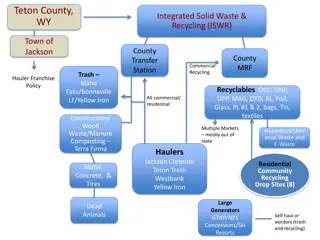Recycling of Animal Washings and Waste in Fodder Production
Animal waste, including excrement and washings, can be recycled to enhance fodder production. By using animal waste as organic mulch or pesticides, farmers can improve soil fertility and crop yield in sustainable agriculture practices. This method also supports organic farming, with benefits for both crops and fruits. The panchgavya mixture, made from cow dung and urine, acts as a natural fertilizer for seeds, promoting healthy growth. Embracing these practices can lead to a more environmentally friendly and efficient approach to fodder production.
Download Presentation

Please find below an Image/Link to download the presentation.
The content on the website is provided AS IS for your information and personal use only. It may not be sold, licensed, or shared on other websites without obtaining consent from the author. Download presentation by click this link. If you encounter any issues during the download, it is possible that the publisher has removed the file from their server.
E N D
Presentation Transcript
Recycling of Animal Washings and Waste in Fodder Production 1
The term animal waste comprises, the fresh excrement, including both solid and liquid excreta i.e. faeces and urine. It also includes the bedding material, animal washings, feed waste and straw which are having considerable manorial value. The characteristics of the livestock wastes depend on fractions of the digestibility, composition of feed ration and species of animals and their physiology. The waste from ruminants has different composition than obtained from pig and poultry which is having high nutritive value. 2
For fodder production, the animal waste can be utilized in many way i.e. as pesticide and i.e. as a non-conventional source energy as pesticides bio-fertilizer to improve soil fertility for sustainable agriculture. This livestock waste can be recycled in following ways: 3
Organic mulch Mulch is artificially or naturally applied layer of plant residue or other material (i.e. feed waste and bedding material from animal houses) on the surface of soil aimed to protect and feed the roots of plants. This is a unique and simple method particularly for recycling of dried and nitrogen deficient organic materials. By mulching, the population of nitrogen fixers and phosphorus solubilisers increases by several folds. 4
As pesticides: Traditionally, the cow dung is used as pesticides in Indian villages particularly in desert area to preserve seeds from insects and pests. The cow dung and urine may be used to prepare pesticides especially neem and tulsi. with plant organics 5
In organic farming: Now a day, many educated farmers prefer organic farming for various crops and fruits e.g. in Maharashtra grapes and pomegranates are now being exported to middle east and European countries produced fruits fetch more price. This farming is also being adopted in some villages of Sri Ganganagar district of Rajasthan for production of wheat crop. where organically 6
Contd.. The panchgavya prepared by using 100g cow dung + 100 ml cow urine + 100 ml cow milk + 100g ghee + 100 ml of water. This panchgavya is used to soak tomato seeds for ten minutes and after drying in shades, when used these seeds shows healthy and vigorous growth of tomatoes. Proper utilization of cow dung and cow urine into manure, pesticides, medicines and other daily products can generate millions of employment opportunities in rural areas. 7
Biogas production: Biogas is a clean, efficient, and renewable source of energy, which can be used as a substitute for other nonrenewable fuels in order to save energy in rural areas particularly in developing countries of Asia and Africa. ] Pure biogas stored in cylinders is a marketable product and hence, can be easily used any time anywhere as LPG cylinders. 8
Contd.. Biogas can be used to generate power through biogas based power generator set. About 0.75-0.8 m biogas can generate 1 unit (1 kWA) of electricity and 10 kVA genset, if runs for 8 h can produce 80-90 units. 9
Composting: Composting is a natural aerobic process that stabilizes a variety of organic matter and livestock manure. Well composed manure has the odor of humus. Because of the heat produced during composting, well-controlled results in the destruction of both pathogens and weed seeds. The pile composting is most common in India. composting 10
Vermicomposting: The earthworms eat the organic matter and excrete little pelleted vermicompost . During vermicomposting, the important plant nutrients, such as N, P, K, and Ca present in the organic waste are released and converted into forms that are more soluble and available to the plants. Vermicompost also contains biologically active substances such as plant growth regulators. material called 11
Profitable manure management by livestock fish integration: Slurry mixed water is very hazardous if not handled properly; however, simultaneously it is source of nutrients that can be recycled through integrating farming. Traditional practices of recycling effluent through agriculture, horticulture and aquaculture have been in used in several countries. 12
Contd.. Integration of fish with livestock farming is the best method for recycling of organic wastes. Cattle manure has been used extensively in India as a source of manure in carp polyculture. Wallowing pond made for buffaloes for fresh water aquaculture with fish yield may be used without any supplementary feeding. 13
Thank You 14























